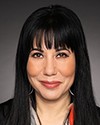Thank you so much.
I am joining you today from Nogojiwanong, the "place at the end of the rapids" on Treaty 20 Michi Saagig territory.
We are all familiar with the terms “domestic violence”, “abusive relationships”, “violence against women”, “partner abuse” and “intimate violence”, and we know the acronyms DV, VAW and IPV. There's power in language. The choices we make to describe a person, an event, a crisis, a disease or a catastrophe anchor images in our individual and collective psyches, and the stories we tell become the foundation of the things we believe.
Thank you for this opportunity to contribute to the work of the standing committee. You have now received more than 58 briefs. You've heard from over 52 witnesses. You have access to StatsCan data. There's a report card on Canada's actions on UN sustainable development goal number five, which is gender equality. There are public resources on federal websites that explain gender-based violence and offer to help those who experience violence.
I can say that I'm a survivor of violence, but what does that tell you about me? I was seven when a strange man exposed himself to me and my cousin, and 10 when roadwork crews began wolf-whistling and calling out sexual invitations. I was 17 when I was surrounded by five drunk, young men on my way home one evening. I was 22 when I married a man who used abusive tactics to control me. I was 30 when I started working in the women's anti-violence sector. I was 38 when I changed my life, and 60 when a man with power slammed a table between us at a public meeting. Throughout my life, I, like many other women in Canada, have been subjected to daily reminders of my fragile safety on the street, in the news, at meetings and in the movies.
Descriptions of physical, sexual, emotional and psychological violence experienced by women—let me rephrase that. Descriptions of violence imposed on women by men, focus on the women, and our response thus far has been to get women away to safety. That's important. We know lots about the victims and not so much about the antagonists and that guy—those guys, who have more physical, financial, and decision-making power. We all know it. We see it in movies, in our families, in our institutions, in corporations and in public office. The continuum of harmful behaviours is long and the harm caused is deep.
Here's what I suggest. I have five or six things. UN sustainable development goal number five, gender equality, is an important stand-alone goal, but it can't function alone. All 17 goals have to work together to ensure that Canada's work is informed by an intersectional gender equity lens if we hope to achieve our goals by 2030.
Words matter. Let's describe the behaviour and the person responsible for causing harm, inflicting gender-based violence or reinforcing gendered assumptions. Stop hiding the protagonist from view. The term “partner”, for instance, implies respect, trust and shared goals. I don't use “partner violence”, because a partner isn't violent.
We need to achieve optimal health and participation. Canada's work developing and promoting the social determinants of health provides 12 determinants that we can use as a lens or a checklist when developing new policies, programs and data collection. Intersectionality—I know you've heard it before—is a lens that was described by legal scholar, Kimberlé Crenshaw back in 1989. That can be used to surface the systems of oppression that overlap to create distinct barriers for people with multiple identity categories.
We need stronger community-based responses and data collection. The brief that was submitted to the committee in February of this year references two primary data sources for measuring intimate partner violence. Please fund women's organizations to support robust data collection and describe the impact of programs. The Women Speak project is a good example.
We are accustomed to seeing solutions to move women out of violence and to move women away from their homes, but that isn't the answer.






